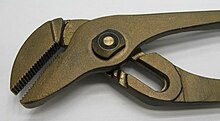Beryllium copper
Beryllium copper or copper beryllium , formerly also known as beryllium bronze or copper beryllium bronze , is an alloy of copper with 0.4 to 2% beryllium . Other alloy components such as B. cobalt , nickel or silicon to match the alloy properties to the specific application, or to save beryllium (costs, health reasons) without having to accept disadvantages in the functional alloy properties. With cobalt as an alloy component, the material is often referred to as CuCoBe in semi-finished products . The most important manufacturers of copper-beryllium alloys are NGK Berylco, a subsidiary of NGK Insulators , and Materion Brush Beryllium & Composites.
Composition and manufacture
There are generally two categories of copper-beryllium alloys, high-strength and high-conductivity materials. The high-strength alloys contain 1.6 to 2.9% by weight of beryllium, with cobalt additions of up to 1% by weight in the copper matrix. The most important of the high-strength alloys is alloy 25 (UNS C17200), with 1.80 to 2.00% by weight of Be. Annealing at 750 to 825 ° C for 5 minutes or more followed by water quenching leaves the beryllium in solid solution at room temperature. The alloy can then be cold worked and processed into finished product shapes. Precipitation hardening can be carried out by aging for 0.5 to 3 hours at 315 to 400 ° C. Tensile strengths of up to 1500 MPa were observed for the cured state. The electrical conductivity of alloy 25 is 22 to 25% IACS (International Annealed Copper Standard). A leaded version of this alloy has improved machinability. A slightly cheaper high strength composition with 10% lower tensile properties is used for small electrical components. Alloy 165 (UNS C17000) is slightly cheaper due to its lower (1.6% by weight) beryllium content. It is used for Bourdon electrical contacts, springs, terminals, switches, bellows, and pressure gauges . Tapes in the range from 0.03 to 0.40 mm thick are often used as the basis for manufacturing these products. The highly conductive alloys have a low beryllium content of 0.3 to 0.8% by weight and a high cobalt content of 1.4 to 2.7% by weight. The most commonly used alloy is 0.5% by weight Be and 2.5% by weight Co. It can be solution annealed at 900 to 940 ° C. The aging takes place at 425 to 540 ° C for 1 to 4 hours. The maximum strength for these alloys is in the range of 700 to 900 MPa. Beryllium metal has an electrical and thermal conductivity that is about 40% that of copper. An electrical conductivity of 40 to 60% IACS is typical.
properties
Beryllium copper has some special properties:
- When it is annealed, it becomes soft and can then be forged into the desired shape . A renewed heating to 300 degrees Celsius allows the alloy to harden again . The hardness can be further increased by cold hammering.
- Despite its hardness, a hammer with a beryllium copper head does not strike sparks, which is why tools made from this material are used wherever work is carried out in potentially explosive areas (oil rigs, gas works, refineries).
- Like other alloys, beryllium copper is available in various hardnesses ( springs made of beryllium copper can withstand many more bends than the best steel spring - and unlike the latter, they are not ferromagnetic ).
- The electrical conductivity is high compared to steel (approx. 10 · 10 6 S / m to 35 · 10 6 S / m) but significantly lower than that of pure copper (approx. 58 · 10 6 S / m).
- Beryllium copper is very resistant to chemicals.
use
Beryllium copper is used, for example, for highly stressed springs in machines, contact springs in relays , electrical contact contacts, for non-sparking tools, for injection molds, in engine construction for valve seat rings. Pistons for muzzle loading weapons are also made of beryllium copper, as they are exposed to high mechanical, thermal and chemical loads.
Beryllium copper is also used for casting molds, so-called permanent molds , for brass casting .
Security notice
The alloying element beryllium is very poisonous . Care should therefore be taken to ensure that no respirable Be particles are created during processing , as is the case, for example, with grinding , welding and solution annealing . When inhaled, berylliosis can occur in rare (less than 4%) cases . Machining (milling, turning, drilling) is to be classified as harmless, as no small particles can get into the air. There are currently no technical guide concentrations or MRK values.
Individual evidence
- ↑ NGK
- ^ High-Performance Copper Beryllium Alloys. In: materion.com. Retrieved March 21, 2017 (English).
- ↑ Kenneth A. Walsh: Beryllium Chemistry and Processing . ASM International, 2009, ISBN 978-0-87170-721-5 , pp. 27 ( limited preview in Google Book search).
- ↑ Data sheet for material beryllium copper (CuBe2). (PDF; 222 kB) WMA Schmidt & Bittner GmbH, July 2015, accessed on March 21, 2017 .
